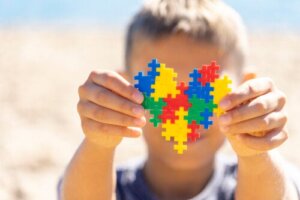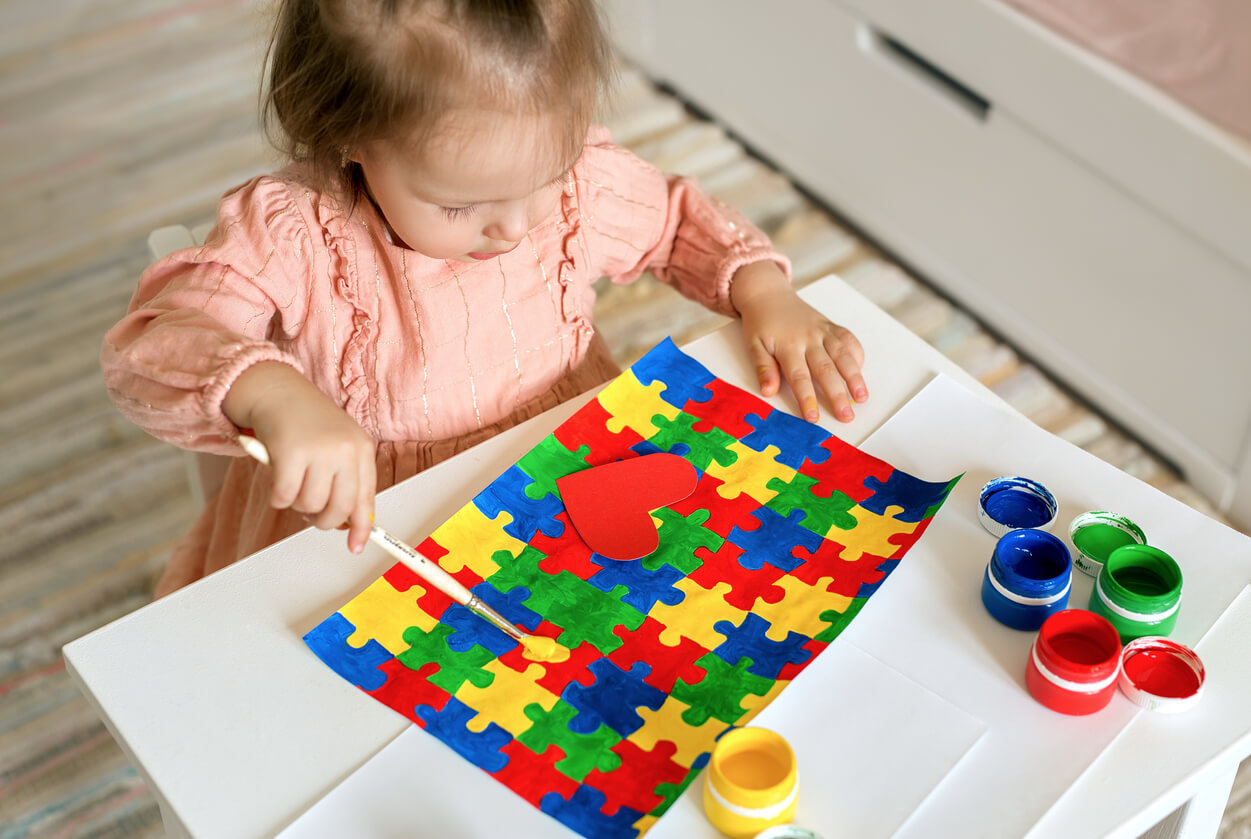Neurodiversity in Children: Everything You Need to Know


Written and verified by the psychologist Elena Sanz Martín
We’re used to thinking that all people are the same, unless we have a problem. Therefore, parents expect their children to react and behave just as other children their age do. However, when this doesn’t happen, they look for ways to help them fit into that mold. But what if the way forward was not to try to eliminate differences but to learn to respect them? To go deeper into this idea, we want to talk to you about neurodiversity in children.
This is a term that has gained prominence in recent times, as it gives a name to the reality experienced by many people who feel, perceive, and relate to the world in a different way than what’s typical. Neurodiversity helps to explain certain behaviors and difficulties. Therefore, it not only provides an identity to children who feel reflected by this concept but also helps their families to understand them, accompany them, and make sense of their differences.
What is neurodiversity?
The term neurodiversity was coined in the 1990s by sociologist and activist Judy Singer. With this word, she intended to reflect the differences in terms of neurological and brain functioning that exist among human beings.
However, from a statistical point of view, a large part of the population shares the same characteristics. These, therefore, have become the norm, and those who possess them are known as neurotypicals. On the other hand, there’s a certain minority, between 15 and 20%, who have a different neurological development. In this case, they’re called neuroatypical or neurodivergent.
These differences are observed in certain specific areas:
- Neurological characteristics: Their brain functions differently, so they experience reality, learn, and interpret information differently.
- Sensory processing: They perceive sensory stimuli (sounds, lights, smells, and textures) in an exacerbated or diminished way compared to the general population.
- Communication: Elements such as eye contact, metaphors, indirect communication, or small talk don’t feel comfortable or natural to these individuals. On the other hand, they may prefer direct language and intense, in-depth conversations on topics that are of interest to them.
- Social relationships: They may not reciprocate in social exchanges, need more time alone than others, or have very intense or variable emotions. This often makes interactions with others and bonding difficult.

Neurodiversity in children
Traditionally, neurodivergent individuals have been considered to be those who present, among others, some of the following disorders or conditions:
- Autism Spectrum Disorder (ASD)
- Attention deficit hyperactivity disorder (ADHD)
- Tourette’s syndrome
- High abilities
- Learning disorders, such as dyslexia, dysgraphia, or dyscalculia
How neurodivergence affects various domains
However, the concept has been broadened to accommodate those individuals who, without possessing or attaining a clinical diagnosis, identify with the challenges inherent to neurodivergence. In any case, as we’re talking about a type of neurological functioning, it’s present from the beginning and accompanies the person throughout their life. For the same reason, children, in their early years, can already begin to suffer the consequences of “being different”.
Because the world isn’t made for them, these children may have difficulties in several areas:
- At school (low performance and anxiety).
- In relationships with peers (they suffer rejection, misunderstanding, and difficulties in making friends).
- Within the family, as the bonds between parents and children can be tense and the home environment hostile due to a lack of information about neurodiversity in children.
Understanding and respecting differences
Precisely, the goal of neurodiversity as a movement is to make us aware that neuroatypical people aren’t defective or sick, but different. Therefore, the objective isn’t to make them conform to the rest of the world or change their way of being but to learn to identify, value, and respect these differences.
On the one hand, let’s keep in mind that neurodiversity in children is often accompanied by very positive advantages and qualities, such as the following:
- They excel in creativity, lateral thinking, and the ability to find original solutions or innovative ways of proceeding.
- They’re good at analyzing and finding patterns and relationships that others may not be able to see.
- They can acquire great knowledge and wisdom on certain topics and areas of their interest.

It’s society that needs to adapt
But, beyond this, the key is to understand that the world belongs to everyone and that these children don’t have to adapt to what society expects of them. On the contrary, it’s society that must open up to diversity and understand and respect the differences and needs of these children. Human neurodiversity is normal and valuable, so it’s not a deficiency that needs to be corrected. However, this doesn’t mean that these children can’t receive support. On the contrary, it’s very important that both they and their close environment learn about neurodivergence and ways and strategies to develop the potential of these children to make their lives easier and fuller.
Accompany their development with love and empathy
Being a parent of a neuroatypical child is undoubtedly a challenge. However, it’s essential for parents to understand and respect how their children’s brains work in order to accompany them with love, understanding, and empathy in their development. In this regard, it’s important to see a professional, first of all, to make an assessment and obtain a diagnosis. But, above all, to receive guidance on what guidelines to apply in the specific case of each child.
We’re used to thinking that all people are the same, unless we have a problem. Therefore, parents expect their children to react and behave just as other children their age do. However, when this doesn’t happen, they look for ways to help them fit into that mold. But what if the way forward was not to try to eliminate differences but to learn to respect them? To go deeper into this idea, we want to talk to you about neurodiversity in children.
This is a term that has gained prominence in recent times, as it gives a name to the reality experienced by many people who feel, perceive, and relate to the world in a different way than what’s typical. Neurodiversity helps to explain certain behaviors and difficulties. Therefore, it not only provides an identity to children who feel reflected by this concept but also helps their families to understand them, accompany them, and make sense of their differences.
What is neurodiversity?
The term neurodiversity was coined in the 1990s by sociologist and activist Judy Singer. With this word, she intended to reflect the differences in terms of neurological and brain functioning that exist among human beings.
However, from a statistical point of view, a large part of the population shares the same characteristics. These, therefore, have become the norm, and those who possess them are known as neurotypicals. On the other hand, there’s a certain minority, between 15 and 20%, who have a different neurological development. In this case, they’re called neuroatypical or neurodivergent.
These differences are observed in certain specific areas:
- Neurological characteristics: Their brain functions differently, so they experience reality, learn, and interpret information differently.
- Sensory processing: They perceive sensory stimuli (sounds, lights, smells, and textures) in an exacerbated or diminished way compared to the general population.
- Communication: Elements such as eye contact, metaphors, indirect communication, or small talk don’t feel comfortable or natural to these individuals. On the other hand, they may prefer direct language and intense, in-depth conversations on topics that are of interest to them.
- Social relationships: They may not reciprocate in social exchanges, need more time alone than others, or have very intense or variable emotions. This often makes interactions with others and bonding difficult.

Neurodiversity in children
Traditionally, neurodivergent individuals have been considered to be those who present, among others, some of the following disorders or conditions:
- Autism Spectrum Disorder (ASD)
- Attention deficit hyperactivity disorder (ADHD)
- Tourette’s syndrome
- High abilities
- Learning disorders, such as dyslexia, dysgraphia, or dyscalculia
How neurodivergence affects various domains
However, the concept has been broadened to accommodate those individuals who, without possessing or attaining a clinical diagnosis, identify with the challenges inherent to neurodivergence. In any case, as we’re talking about a type of neurological functioning, it’s present from the beginning and accompanies the person throughout their life. For the same reason, children, in their early years, can already begin to suffer the consequences of “being different”.
Because the world isn’t made for them, these children may have difficulties in several areas:
- At school (low performance and anxiety).
- In relationships with peers (they suffer rejection, misunderstanding, and difficulties in making friends).
- Within the family, as the bonds between parents and children can be tense and the home environment hostile due to a lack of information about neurodiversity in children.
Understanding and respecting differences
Precisely, the goal of neurodiversity as a movement is to make us aware that neuroatypical people aren’t defective or sick, but different. Therefore, the objective isn’t to make them conform to the rest of the world or change their way of being but to learn to identify, value, and respect these differences.
On the one hand, let’s keep in mind that neurodiversity in children is often accompanied by very positive advantages and qualities, such as the following:
- They excel in creativity, lateral thinking, and the ability to find original solutions or innovative ways of proceeding.
- They’re good at analyzing and finding patterns and relationships that others may not be able to see.
- They can acquire great knowledge and wisdom on certain topics and areas of their interest.

It’s society that needs to adapt
But, beyond this, the key is to understand that the world belongs to everyone and that these children don’t have to adapt to what society expects of them. On the contrary, it’s society that must open up to diversity and understand and respect the differences and needs of these children. Human neurodiversity is normal and valuable, so it’s not a deficiency that needs to be corrected. However, this doesn’t mean that these children can’t receive support. On the contrary, it’s very important that both they and their close environment learn about neurodivergence and ways and strategies to develop the potential of these children to make their lives easier and fuller.
Accompany their development with love and empathy
Being a parent of a neuroatypical child is undoubtedly a challenge. However, it’s essential for parents to understand and respect how their children’s brains work in order to accompany them with love, understanding, and empathy in their development. In this regard, it’s important to see a professional, first of all, to make an assessment and obtain a diagnosis. But, above all, to receive guidance on what guidelines to apply in the specific case of each child.
All cited sources were thoroughly reviewed by our team to ensure their quality, reliability, currency, and validity. The bibliography of this article was considered reliable and of academic or scientific accuracy.
- Brown, H. M., Stahmer, A. C., Dwyer, P., & Rivera, S. (2021). Changing the story: How diagnosticians can support a neurodiversity perspective from the start. Autism, 25(5), 1171-1174.
- Silberman, S. (2017). Neurodiversity rewires conventional thinking about brains. In Beginning with disability (pp. 51-52). Routledge.
This text is provided for informational purposes only and does not replace consultation with a professional. If in doubt, consult your specialist.








